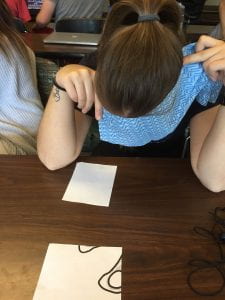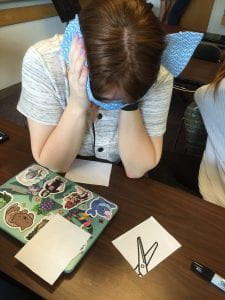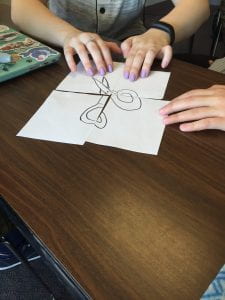Rules:
For 4 Players (and 1 moderator)
- A picture is cut up into four pieces. The moderator assigns each player one of these pieces.
- The moderator places one of the pieces face down on the table and ensures that the player has the blindfold held up to their face and is ready. Then, the piece is flipped over and the player has 10 seconds to look at and memorize the image. At this point, the other three players must be facing another direction.
- After the ten seconds are up, the player must then draw out a recreation of what they saw on a piece of paper. Once they are finished, the turn of the next player will begin. This process will continue through the players one by one.
- After all players have seen and drawn their piece, they must put together their pieces and attempt to figure out what the original image was. If their guess is correct, they win.
Documentation:



Artist’s Statement:
When we were first assigned this piece, I immediately thought of the aspect of Dadaism where something practical is altered so that it no longer functions for its original purpose. Based off of the pieces shown in the book and some of the works that we discussed in class, this seemed to be a reoccurring theme throughout the movement and I wanted to do something in a similar vein.
With this in mind, I started to think of things that could be changed so that they would not do what they were made to do. This reminded me of a set of wash clothes that I had bought from Target a few weeks prior. I had tried to use them while cleaning my room once and found that they were absolutely terrible – if anything, they made my room messier by not absorbing anything and spreading it around instead. In a sense, the manufacturers of the wash cloth had already done my work for me. They made an object that was useless for accomplishing its original purpose.
As I was playing around with the wash cloth to see what kinds of things I could do with it, I noticed that the fabric was somewhat porous (presumably so that it would be able to soak up a mess) and if you stretched it out and looked at it from the right distance, you could see through it. It wasn’t perfectly transparent, though, so I thought that I could use it as a blindfold of sorts.
This set the goal of my game into place. To be able to decipher an image while looking through the cloth. I experimented with looking at different images while blindfolded and noted that simple, basic outlines were the best bet. But it wasn’t much of a game to simply look at a picture through a cloth and then say what it is, so I split the image into four parts to add some challenge to the game. Players would have to cooperate in order to get the whole picture.
That did, of course, add the drawing element to the game. Unless everyone had photographic memory and could perfectly describe what they had seen, they would needed to be able to draw their section. Unfortunately, the clothes weren’t long enough to be wrapped around a head and tied like a proper blindfold, so I simply had players look at the image through the cloth, then draw it afterwards. I placed a time limit on how long they could look at the image for because I noticed that, if you got skilled at stretching the cloth just right, it wasn’t much of a challenge to see through it. I gave the players 10 seconds to look at the image so that, hopefully, they wouldn’t have the time to get accustomed to using the cloth.
The actual gameplay is quick, fun, and confusing at times, which was great because I felt like those qualities kind of captured the essence of Dada.
